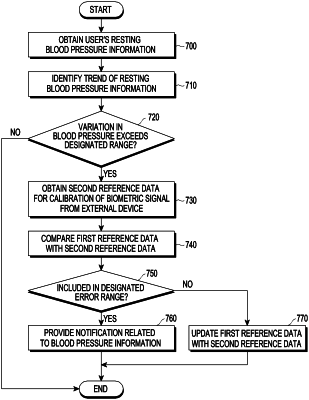| CPC A61B 5/7221 (2013.01) [A61B 5/0006 (2013.01); A61B 5/02108 (2013.01); A61B 5/02416 (2013.01); A61B 5/6898 (2013.01); A61B 5/7475 (2013.01); A61B 5/742 (2013.01)] | 10 Claims |

|
1. An electronic device, comprising:
a display;
a motion sensor;
a photoplethysmogram (PPG) sensor;
a wireless communication circuit;
a processor operatively connected with the display, the motion sensor and the PPG sensor; and
a memory operatively connected with the processor, wherein the memory stores instructions configured to, when executed, enable the processor to:
obtain first data from the motion sensor and second data from the PPG sensor,
identify whether a user's activity state is resting state based on the first data and the second data, when the first data does not exceed a first specified range and the second data does not exceed a second specified range, and
when the user's activity state is the resting state, obtain blood pressure data from the PPG sensor,
identify whether an amount of change in the blood pressure data exceeds a third specified range,
obtain second reference data, from an external electronic device connected to the electronic device using the wireless communication circuit, for updating first reference data when the amount of change in the blood pressure data exceeds the third specified range,
compare the first reference data and the second reference data,
identify whether a result of comparison between the first reference data and the second reference data exceeds a fourth specified range,
when the result of the comparison exceeds the fourth specified range, update the first reference data to the second reference data, and
based on the second reference data, perform a calibration process.
|